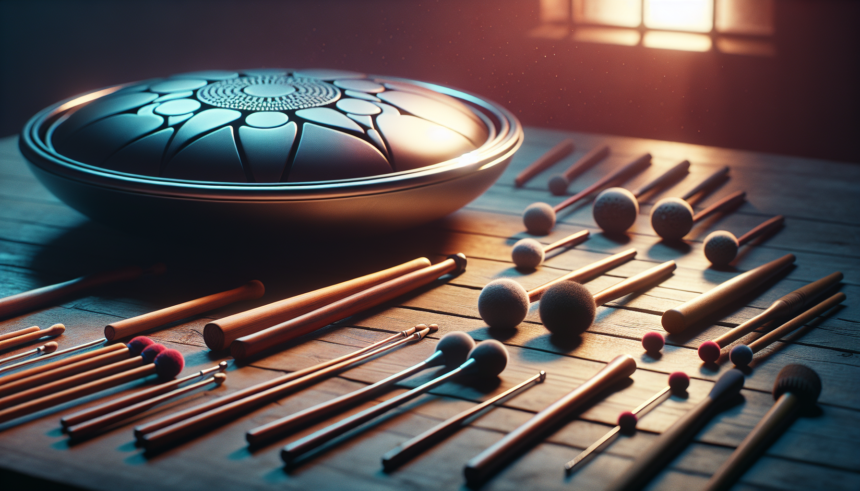The handpan, a relatively recent addition to the world of musical instruments, is cherished for its soothing, resonant tones. Unlike traditional percussion instruments, the handpan creates a harmonious amalgamation of melody and rhythm. Mastery over this instrument often hinges on the subtle nuances of your playing technique and equipment choice, and one critical component that significantly influences the quality of the sound is the mallet you use. In this article, we will explore the attributes and considerations necessary for choosing the right handpan mallet to craft the perfect strike.
Understanding Handpan Mallets
Handpan mallets are unique in their design and purpose. Unlike standard drumsticks, they are engineered to produce a soft yet crisp sound that complements the melodious nature of the handpan. Typically, these mallets come with a padded or felt tip to reduce the percussive impact and emphasize the handpan’s harmonic overtones. Considerations such as material, weight, and handle design play critical roles in influencing the sound quality and playability of the instrument.
Material Varieties
The material of a mallet’s tip is arguably the most influential factor in its sound production. The following materials are commonly used:
Felt-Tipped Mallets
Felt-tipped mallets are popular due to their ability to produce a warm, mellow sound. The softness of the felt cushions the impact, resulting in a less aggressive strike. This type of mallet is ideal for sustained, meditative play and is well-suited for ambient music.
Rubber-Tipped Mallets
Rubber-tipped mallets offer a more pronounced attack and are capable of producing a wider dynamic range. The increased stiffness allows for a sharper, more defined sound. These mallets are versatile and can adapt to varied playing styles, making them suitable for both soft and loud passages.
Wooden and Other Hard-Tipped Mallets
Hard tips, such as those made from wood, produce the most distinct and clear sounds. However, they can sometimes be too harsh for the delicate nature of a handpan. These mallets are less commonly used but can be useful for specific techniques and effects.
Weight and Balance
The weight and balance of a mallet significantly affect the playing experience. Heavier mallets provide more momentum and generally require less effort to produce sound, which can be advantageous for longer playing sessions. However, they can also lead to fatigue if not well-balanced.
On the other hand, lighter mallets offer greater control and precision, making them ideal for detailed and intricate playing. A well-balanced mallet should feel comfortable in your hand, with the weight distributed evenly from the handle to the tip, allowing for a natural and fluid striking motion.
Handle Design
The handle design of a mallet is another important aspect to consider. Handles can be made from various materials, including wood, bamboo, and synthetic composites. Each type has its own characteristics:
Wooden Handles
Wooden handles are traditional and provide a natural feel. They are warm to the touch and offer a good grip. However, they can vary in weight and flexibility depending on the wood type used.
Bamboo Handles
Bamboo is lightweight and slightly flexible, offering a unique feel. It provides a decent balance of stiffness and comfort, making it a popular choice for many players.
Synthetic Handles
Synthetic handles, such as those made from carbon fiber or fiberglass, are highly durable and lightweight. They offer consistency in weight and flexibility but may lack the tactile warmth of natural materials.
Length and Diameter
Handpan mallets come in various lengths and diameters. The right size for you will depend on your hand size, playing style, and the handpan itself. Typically, longer mallets provide more leverage for powerful strikes, while shorter ones offer greater control. The diameter should allow for comfortable gripping without straining your hand or fingers.
Tonal Quality and Timbre
The interplay of all these elements—material, weight, balance, handle design, length, and diameter—culminates in the tonal quality and timbre that the mallet produces. It’s essential to test how these factors interact with your specific handpan. Some handpans resonate more with softer strikes, while others benefit from a firmer touch. Experimenting with different mallets on your handpan can help you find the best match for your desired sound.
Personal Preference and Playing Style
Ultimately, the choice of a handpan mallet is highly personal. Your playing style, the genre of music, and even your mood can influence your preference. Some players prefer softer mallets for a gentle, caressing sound, while others opt for harder tips to articulate intricate rhythms. It’s important to have a variety of mallets in your toolkit to adapt to different musical contexts and to allow your creativity to flow unhindered.
Recommendations for Beginners
If you are new to the handpan, start with a pair of felt-tipped mallets. These mallets usually offer a forgiving and balanced sound, making them suitable for beginners. As you gain more experience, you can experiment with other types to expand your sonic palette. Avoid overwhelming yourself with too many choices at the beginning; focus instead on mastering your basic strokes and rhythms.
Maintenance and Care
Taking proper care of your mallets will ensure their longevity and consistent performance. Regularly inspect the tips for wear and tear, as damaged tips can affect the sound quality and even harm your handpan. Clean the handles to remove any dirt or sweat buildup, especially if they are made from natural materials like wood or bamboo. Store your mallets in a cool, dry place to prevent warping, and consider using a protective case to safeguard them during transport.
Selecting the right handpan mallet is a nuanced process that involves understanding various factors such as material, weight, balance, handle design, length, and diameter. The ideal mallet should complement your playing style, enhance the tonal quality of your handpan, and feel comfortable in your hand. While felt-tipped mallets are a great starting point for beginners, exploring different types allows you to fully realize the diverse sonic possibilities of your handpan. Ultimately, the perfect mallet is one that not only produces the desired sound but also inspires you to create beautiful music.
1. Can I use drumsticks for playing the handpan?
It is generally not recommended to use drumsticks for playing the handpan as they are too hard and can damage the instrument. Handpan mallets are specifically designed with softer tips to produce the appropriate sound without causing harm.
2. How do I know if my mallets are too hard for my handpan?
If your mallets are producing a sharp, unpleasant sound or if you notice any denting or damage on the surface of your handpan, it is likely that the mallets are too hard. Opt for softer tips to ensure a harmonious sound and protect your instrument.
3. Are there specific mallets for different handpan notes or scales?
While there aren’t specific mallets for different notes or scales, different mallets can enhance certain tonal qualities. Experimenting with various mallet types can help you achieve the desired sound for different notes and scales on your handpan.
4. How often should I replace my handpan mallets?
The lifespan of handpan mallets depends on their material and how frequently they are used. Regularly check for signs of wear and tear, especially on the tips. Replace them when they no longer produce the desired sound or show significant damage.
5. Can I make my own handpan mallets?
Yes, making your own handpan mallets is possible and can be a rewarding experience. Ensure you use materials that are soft enough to avoid damaging the handpan, and experiment with different combinations to find the sound you prefer.





